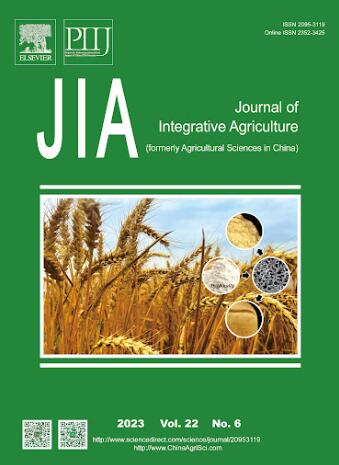推迟播种期能否改善四川盆地机插秧水稻的食用和烹饪品质?
IF 4.4
1区 农林科学
Q1 AGRICULTURE, MULTIDISCIPLINARY
引用次数: 0
摘要
调整播种期是水稻生产中广泛采用的一项措施,以适应高温条件。然而,延迟播种期(DS)对稻米品质的影响可能因品种和生态条件而异。在本研究中,我们使用不同的播种日期,即常规播种日期 1(CS1)、CS2(比 CS1 晚 10 天)、DS1(比 CS1 晚 30 天)和 DS2(比 CS2 晚 30 天),以及三个水稻品种,即 "宜香优 2115"、"福优 498 "和 "川优 6203",进行了试验。该试验于 2018 年和 2019 年在四川盆地的 4 个地点进行,旨在评估 DS 对大米糊化性的影响,而糊化性是食用和烹饪品质(ECQ)的代表。与CS1和CS2相比,DS1和DS2的大米直链淀粉含量(AC)显著增加,但蛋白质含量(PC)、峰值粘度(PKV)、冷糊化粘度(CPV)和热糊化粘度(HPV)却较低。此外,除2018年的CS2和DS1外,DS1和DS2导致分解粘度(BDV)降低2.15-11.19%,挫粘度(SBV)增加23.46-108.47%。然而,DS 对水稻糊化性能的影响因研究地点和水稻品种而异。2019年,DS1和DS2在大邑、安州、南部和射洪分别导致BDV降低2.35-9.33%、2.61-8.61%、10.03-17.78%和2.06-8.93%,SBV增加2.32-60.93%、63.74-144.24%、55.46-91.63%和-8.28-65.37%。与川优 6203 和福优 498 相比,DS 导致宜香优 2115 的 PKV、HPV、CPV 和 BDV 下降幅度更大,AC 和 SBV 上升幅度更大。相关分析表明,PKV 和 HPV 与打顶后的平均温度、最高温度和最低温度显著正相关。这些温度必须高于 25.9、31.2 和 22.3℃,才能增加水稻的相对 BDV 和降低相对 SBV,从而提高 ECQ。总之,DS 可能导致四川盆地机插秧水稻 ECQ 明显下降。要提高水稻的ECQ,需要在水稻抽穗后将平均温度保持在25.9℃以上。本文章由计算机程序翻译,如有差异,请以英文原文为准。
Can a delayed sowing date improve the eating and cooking quality of mechanically transplanted rice in the Sichuan basin?
Adjustment of the sowing date is a widely used measure in rice production to adapt to high-temperature conditions. However, the impact of delayed sowing date (DS) on rice quality may vary by variety and ecological conditions. In this study, we conducted experiments using different sowing dates, that is, conventional sowing date 1 (CS1), CS2 (10 d later than CS1), DS1 (30 d later than CS1), and DS2 (30 d later than CS2), and three rice varieties, i.e., “Yixiangyou 2115,” “Fyou 498,” and “Chuanyou 6203.” This experiment was conducted at four sites in the Sichuan basin in 2018 and 2019 to evaluate the influence of DS on the pasting properties of rice, which are a proxy for eating and cooking quality (ECQ). In DS1 and DS2, rice had a significantly greater amylose content (AC) but a lower protein content (PC), peak viscosity (PKV), cool paste viscosity (CPV), and hot paste viscosity (HPV) than in CS1 and CS2. Moreover, with the exception of CS2 and DS1 in 2018, DS1 and DS2 led to a 2.15–11.19% reduction in breakdown viscosity (BDV) and a 23.46–108.47% increase in setback viscosity (SBV). However, the influence of DS on rice pasting properties varied by study site and rice variety. In 2019, DS1 and DS2 led to a BDV reduction of 2.35–9.33, 2.61–8.61, 10.03–17.78, and 2.06–8.93%, and a SBV increase of 2.32–60.93, 63.74–144.24, 55.46–91.63, and -8.28–65.37% at the Dayi, Anzhou, Nanbu, and Shehong, respectively. DS resulted in a greater decrease in PKV, HPV, CPV, and BDV and a greater increase in the AC and SBV for Yixiangyou 2115 than for Chuanyou 6203 and Fyou 498. Correlation analysis indicated that PKV and HPV were significantly and positively related to the mean, maximum, and minimum temperatures after heading. These temperatures have to be greater than 25.9, 31.2, and 22.3℃ to increase the relative BDV and decrease the relative SBV of rice, thereby enhancing ECQ. In conclusion, DS might contribute to a significant deterioration in ECQ in machine-transplanted rice in the Sichuan basin. A mean temperature above 25.9℃ after heading is required to improve the ECQ of rice.
求助全文
通过发布文献求助,成功后即可免费获取论文全文。
去求助
来源期刊

Journal of Integrative Agriculture
AGRICULTURE, MULTIDISCIPLINARY-
CiteScore
7.90
自引率
4.20%
发文量
4817
审稿时长
3-6 weeks
期刊介绍:
Journal of Integrative Agriculture publishes manuscripts in the categories of Commentary, Review, Research Article, Letter and Short Communication, focusing on the core subjects: Crop Genetics & Breeding, Germplasm Resources, Physiology, Biochemistry, Cultivation, Tillage, Plant Protection, Animal Science, Veterinary Science, Soil and Fertilization, Irrigation, Plant Nutrition, Agro-Environment & Ecology, Bio-material and Bio-energy, Food Science, Agricultural Economics and Management, Agricultural Information Science.
 求助内容:
求助内容: 应助结果提醒方式:
应助结果提醒方式:


